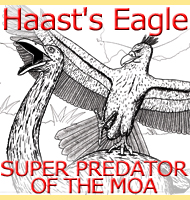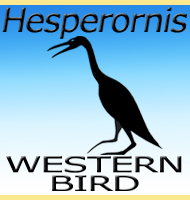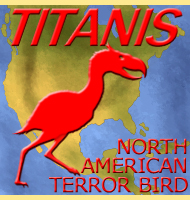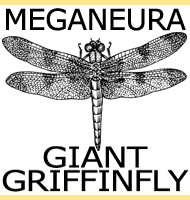


Argentavis
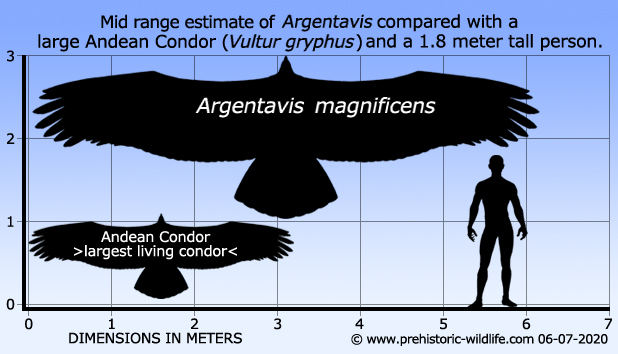
Name:
Argentavis
(Argentina bird).
Phonetic: Ar-jen-tay-vis.
Named By: Campbell & Tonni - 1980.
Classification: Chordata, Aves, Teratornithidae.
Species: A. magnificens
(type).
Diet: Carnivore.
Size: Estimated between 5.5-6.5 meter wingspan,
though some suggest up to 7 meters.
Known locations: Argentina.
Time period: Messinian of the Miocene.
Fossil representation: Several sets of partial
remains.
Take off and Flight
With
a wingspan estimated at seven meters across, Argentavis
was roughly
twice the size of the largest flying bird today (Wandering
Albatross), and only the long extinct pterosaurs
could have
rivalled and exceeded it for size.The genus Pelagornis
is a possible
contender to be roughly equal in size or slightly wider wingspan to Argentavis,
depending upon accuracy of estimates.
How such a large bird like
Argentavis could fly has been the key area of study
associated
with this bird,
something that has resulted in some interesting conclusions. The
first is that the keel of the breastbone is quite small which suggests
the main flight muscles were reduced when compared to other flying
birds. This means that even though the wings were huge, Argentavis
did not have the stamina to continuously flap them.
It’s
most likely that as a result of these under developed muscles
Argentavis relied upon prevailing wind currents to
keep itself aloft
with flapping only occurring during the take-off and landing phases.
This would see Argentavis using its large wings to
exploit a
combination of thermal up draughts as well as dynamic soaring.
Dynamic soaring is essentially where a flying creature uses the
boundary between two air masses to pick up speed by cartwheeling into
oncoming wind and using the wind speed to accelerate itself forward.
Repeating this process further increases the speed of the bird and
resulting effect of the next manoeuvre resulting in an extremely energy
efficient form of flight, one that is now even used by human glider
pilots to stay airborne longer.
Argentavis
also seems to have relied more upon air currents for taking off as the
immense size of its wings means that it could not flap them when
outstretched without the tips hitting the ground. Instead Argentavis
would have had an easier time just stretching out its wings and facing
into the oncoming wind. From this position Argentavis
could run into
the prevailing wind to get air moving across its wing surfaces and then
use its legs to jump up into the air. This would be the most critical
time for Argentavis as getting airborne is not the
same as staying
airborne (ask any pilot). However if Argentavis
had positioned
itself to run down a slope it could have gotten itself airborne while
increasing the distance between itself and the ground just by flying
horizontally level. Argentavis could then flap
its wings while it
adjusted its course to take better advantage of the air currents.
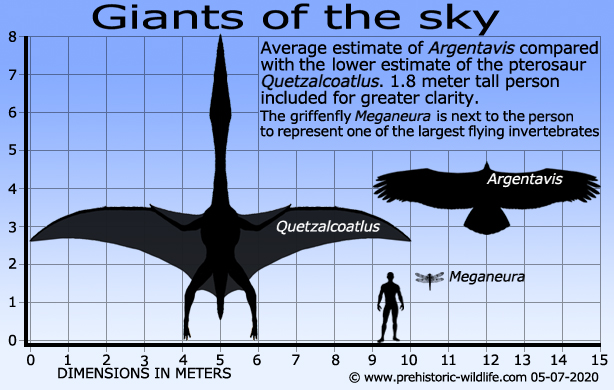
Argentavis
Behaviour
Feeding
behaviour for Argentavis has been hard to
ascertain, but it is
thought to at least be a carnivore. Argentavis is
not thought to have
been an active predator however due to its body shape and comparatively
weak breast muscles. A much more believable behaviour for Argentavis
would be that of a scavenger, perhaps similar to an Andean Condor
(Vultur gryphus), a bird thought to possibly be
the most similar
living bird to Argentavis but less than half its
size. Scavenging
would also require little in the way of active movement, reducing the
required number of calories to keep its body going.
The
huge size of Argentavis meant that it would have
had little trouble in
driving off smaller mammalian predators like Thylacosmilus
away from
its kills. However it should be remembered that the top predators of
Miocene South America were actually another group of birds, the
ground dwelling phorusrhacids
(better known as ‘terror birds’).
These birds had lost the ability to fly but the largest members of the
group such as Phorusrhacos
and Kelenken
were easily able to take down
large prey. It may have been these predators that provided large
amounts of carrion that supported Argentavis’s
scavenging.
Age and Reproduction
While
no one can say for certain how long Argentavis
lived, its large size
and possibly sedate lifestyle when compared to active predators suggest
that it may have been quite long lived. The large size of Argentavis
meant that it also had no known predators in the air while most of the
ground predators where too small to be a threat. Only the larger
phorusrhacids may have been a problem, but still Argentavis
had the
option of flight, they did not. All of these factors combined has
led most palaeontologists to acknowledge the theory that Argentavis
was
probably a very long lived bird that could have had a lifespan
measureable in decades.
If
the above is true then Argentavis may have relied
upon what is termed a
K-strategy to its life. K-strategy is where an animal species lives
at the extent of its ecosystem limit with very little fluctuation in
total numbers. This prevents the species from exhausting limited food
supplies, and if Argentavis was the scavenger
that most people think
it was, then its food sources would have been dependent upon the
success of other hunters and its own ability to find carrion before
other animals had eaten it. The amount of such food would always be
changing, but a smaller and stable population of scavengers would
have been better able to live of this source than a species that
continually overbred.
To
support the K-strategy Argentavis would have likely
invested a lot of
time and effort into raising a small number of young that would have
stayed with the parent birds for a considerable amount of time. This
would have given the young more time to grow strong while greatly
reducing the level of infant mortality in the species. This would
also help stabilise the population numbers, reducing the risk of
overbreeding as the parents would not breed again until a time until
the young where at a stage of development where they could survive on
their own.
Further reading
- A new genus of teratorn from the Huayquerian of Argentina (Aves:
Teratornithidae) - Contributions in Science, Natural History Museum of
Los Angeles County 330: 59–68. - Kenneth E. Campbel Jr &
Eduardo P. Tonni - 1980.
- Size and locomotion in teratorns - Auk 100 (2): 390–403. - Kenneth E.
Campbel Jr & Eduardo P. Tonni - 1983.
- Ecological and reproductive constraints of body size in the gigantic
Argentavis magnificens (Aves, Theratornithidae) from
the Miocene of
Argentina - Ameghiniana 40 (3): 379–385. - Paul Palmqvist &
Sergio F. Vizca�no - 2003.
- Ancient Argentavis soars again. - Proceedings of the National Academy
of Sciences, 104(30), 12233-12234. - D. E. Alexander - 2007.
- The aerodynamics of Argentavis, the world's
largest flying bird from
the Miocene of Argentina - Proceedings of the National Academy of
Sciences of the United States of America 104 (30): 12398–12403. - S.
Chatterjee, R. J. Templin & K. E. Campbell - 2007.
----------------------------------------------------------------------------
Random favourites
 |
 |
 |
